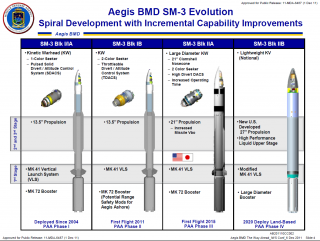The Pentagon's Missile Defense Agency Test-Fired its New, Larger SM-3IIA Interceptor Missile in Space
Why Russia should be VERY worried.
The SM-3 IIA can hit bigger targets, such as incoming enemy ballistic missiles, at longer distances than previous SM-3 interceptor missiles.
The Missile Defense Agency and Raytheon fired a new SM-3 missile variant into space and destroy an approaching enemy missile target - as a way to develop a new interceptor better able to detect and attack ballistic missile threats approaching the earth’s atmosphere from space.
For the first time, the new SM-3 IIA missile intercepted a ballistic missile target firing from the USS John Paul Jones - a Navy destroyer.
"John Paul Jones detected and tracked the target missile with its onboard AN/SPY-1D(V) radar using the Aegis Baseline 9.C2 weapon system. Upon acquiring and tracking the target, the ship launched an SM-3 Block IIA guided missile which intercepted the target," a MDA statement said.
The new SM-3IIA missile is slated to fire from a land-based missile defense site planned by the Pentagon for Poland by 2018, a Missile Defense Agency spokesman, told Scout Warrior in a statement.
The SM-3 Block IIA is being developed cooperatively by the United States and Japan to defeat medium- and intermediate-range ballistic missiles.
The SM-3 Block IIA interceptor operates as part of the Aegis Ballistic Missile Defense system and can be launched from Aegis-equipped ships or Aegis Ashore sites, MDA Spokesman Chris Johnson said in a written statement.
SM-3 missiles, first deployed on Navy ships, are exo-atmospheric interceptor missiles designed to destroy short and intermediate range incoming enemy ballistic missiles in above the earth’s atmosphere. With the weapon, threats are destroyed in space during what’s described as the mid-course phase of flight.
"The SM-3 Block IIA missile is a larger version of the SM-3 IB in terms of boosters and the kinetic warhead, which allows for increased operating time. The second and third stage boosters on the SM-IIA are 21" in diameter,allowing for longer flight times and engagements of threats higher in the exo-atmosphere," Missile Defense Agency spokesman Christopher Szkrybalo told Scout Warrior in a statement prior to this most recent test.
The objective of the test, off the coast of Hawaii, is to demonstrate an intercept of a medium-range ballistic missile target by an SM-3-IIA launched from a U.S. Aegis BMD configured ship at the Pacific Missile Range Facility, Szkrybalo added.
"Today's test demonstrates a critical milestone in the cooperative development of the SM-3 Block IIA missile," said MDA Director Vice Adm. Jim Syring, said in a written statement. "The missile, developed jointly by a Japanese and U.S. government and industry team, is vitally important to both our nations and will ultimately improve our ability to defend against increasing ballistic missile threats around the world."
The planned Poland 2018 deployment is a key part of what the Pentagon calls the Aegis Ashore program, an effort to leverage the ship-based Aegis Radar for land-fired missile defense technology. As of last year, Aegis Ashore locations are already operational in Romania as part of the Obama administration’s European Phased Adaptive Approach program.
The concept with the program is to engineer a land-based missile defense envelope, by using already successful and operational Aegis Radar and SM-3 technology, to better protect the European continent from potential ballistic missile threats.
While not specifically identified for particular countries such as Iran, Russia or other potentially hostile Middle Eastern Countries, the sites are designed to protect Europe and NATO allies from the broadest possible range of missile threats to Europe. Land-based defensive intercept missiles in Romania and Poland, such as the SM-3 variants, could knock-out and destroy approaching missile threats aimed at European targets.
The SM-3 is a kinetic energy warhead able to travel more than 600 miles per hour; it carries no explosive but instead relies on the sheer force of impact and collision to destroy an enemy target.
The new SM-3IIA missile builds upon a smaller existing operational variant of the missile called the SM-3IB, Raytheon officials said.
“This is an extended capbility of what we have for the SM-3 1B. Because of the larger missile this is a 21-inch air frame. we have a larger area of defended area coverage. we've also brought in some capability advancements into our kinetic warhead so now we have a higher sensitivity - so that is just better seeker,” Amy Cohen, Raytheon SM-3 Director, told Scout Warrior in an interview prior to this most recent test.
The SM-3 IIA weapon uses an improved seeker can better see approaching targets from longer distances compared to the SM-3 1B, she added.
Some of these improvements engineered into the missile are described as “sensitivity increases” which use a larger focal plane array for detection and more computer processing power.
The SM-3 Block IIA previously completed two very successful fly-out tests—with no target missile launched, Missile Defense Agency officials said.
In December of 2015, Raytheon received a $543 million SM-3IIA production contract to build the missiles. Some of these missiles will be sent to Poland for the Aegis Ashore site planned for 2018, officials said.
Production of the missile involves a collaborative effort between the Raytheon in the U.S. and Japan. Both Japan and Raytheon produce 50-percent of the missile which is then integrated by Raytheon.
Meanwhile, Raytheon and the MDA are also upgrading the existing SM-3IB missile with improved software such that it can better detect and destroy new threats, Kenyon Hiser, Raytheon’s SM-3 Block IIA program manager, said in an interview with Scout Warrior last year.
Some of the technologies designed for the SM-3IIA are being retrofitted onto the SM-3IB, he added.
This first appeared in Scout Warrior here.

